| This article's lead section may be too short to adequately summarize the key points. Please consider expanding the lead to provide an accessible overview of all important aspects of the article. (February 2024) |
 | |
| Company type | Aktiengesellschaft |
|---|---|
| Industry | Rangefinder camera, Photography, Digital Imaging, Still cameras, SLR cameras, DSLR cameras, binoculars / Monoculars, binocular telescope, laser rangefinder ophthalmic lenses |
| Founded | 1869 in Wetzlar, Germany (Ernst Leitz Wetzlar); 1986 in Solms, Germany (Leica) |
| Headquarters | Wetzlar, Germany 50°33′9″N 008°32′11″E / 50.55250°N 8.53639°E / 50.55250; 8.53639 |
| Key people | Andreas Kaufmann (Chairman, Supervisory board), Matthias Harsch (CEO) |
| Products | Cameras, photographic lenses, binoculars, ophthalmic lenses and other optical equipment |
| Revenue | |
| Net income | Unknown |
| Owner | ACM Projektentwicklung GmbH (55%)
The Blackstone Group (45%) |
| Number of employees | 1800 |
| Website | leica-camera |
Leica Camera AG (/ˈlaɪkə/) is a German company that manufactures cameras, optical lenses, photographic lenses, binoculars, and rifle scopes. The company was founded by Ernst Leitz in 1869 (Ernst Leitz Wetzlar), in Wetzlar, Germany. The name Leica is derived from the first three letters of the founder's surname (Leitz) and the first two of the word camera: lei-ca (LEItz CAmera).
In 1986, the Leitz company changed its name to Leica and moved its factory from Wetzlar to the nearby town of Solms.
Leica Camera AG is 55% owned by Austrian investment firm ACM Projektentwicklung GmbH and 45% owned by The Blackstone Group which licenses the Leica brand name from the Danaher Corporation-owned Leica Microsystems GmbH.
History
| This section is missing information about first 40 years of company history. Please expand the section to include this information. Further details may exist on the talk page. (February 2024) |


From the year 1907 to the 1950s, the buildings that formed Leica factory were built on Ernst Leitz Street in Wetzlar, and remained until 1986, when the factory was moved to the city of Solms. The Wetzlar factory was located on the opposite side of the administrative building of 1957 and formed a special urban architecture; it is upstream from the slope of Kalsmunt and forms a structurally attractive graduation from the skyscrapers to the ruins of Kalsmunt Castle.
In the last decades of the 19th century, Ernst Leitz moved its production facilities to the slopes of Kalsmunt with sufficient residential buildings and workshops on the Laufdorfer Weg.
At the turn of the century, the production of optical devices expanded so much that it originated the first skyscrapers in the city of Wetzlar. The oldest part of this row of tall buildings is now hidden by a new building at the Schützenstraße. The first plans of the architect Jean Schmidt in 1907 show a brick building on a stone base, which was covered by a sloping roof and a slate roof. However, in the same year, it was decided to use the new construction of concrete skeletons and a simpler façade design. The four-story building is divided into six groups of windows, each of which has three windows. Narrow wall patterns and lightly embedded parapets summarize the three lowest floors. The fourth floor is visually separated from the lower part of the building by a very distant cornice. On either side of the central building there was a hip roof with high ceilings. The mansard's floor expanded as production and workers also increased. Only a few years later, Leitz again demanded the construction of a tall building. After the planning of Jean Schmidt, contractor Robert Schneider built a four-story building in 1911.
The basement building was made of reinforced concrete with brick stairs. Again, the original plan, which provided a horizontal structure of the building through the cornucopia, was abandoned in favor of a simpler façade design. In the ten-axis building, similar to the oldest skyscraper, the lower levels are grouped by pilasters. The space between the two skyscrapers (which originally had been provided with subsequent buildings) had to be closed by another building in the early 1930s. Once again, it was Jean Schmidt, who prepared the plans for a first seven-story skyscraper. The still existing façade drawings show the columns with arches on the ground floor and that are fitted between a long strip of windows with excessive pilasters. The general design shows a mixture of very graphic elements and remains of curved Modernist forms that recall the buildings by Joseph Maria Olbrich at Mathildenhöhe of Darmstadt.
In 1936, the architect presented a completely revised plan. The plan was now made up of eight floors for Leica production. The building was built with a concrete construction modeled from the production halls of Opel in Rüsselsheim, Zeiss in Jena and Wernerwerk in Berlin. It was possible to access all the floors through two stairs.
The government of the city and the district finally approved a construction of eight floors with a loggia-like ninth floor, that later was closed. Due to the urban landscape that characterized the size of the building, the planning of the district government was initially rejected because of a simple and unsatisfactory exterior design. Even so, the building was built in 1938 between the two oldest skyscrapers. In 1950, west of the skyscraper of 1911, a skyscraper of similar construction with nine floors was added.
Before WWII
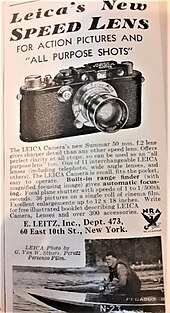



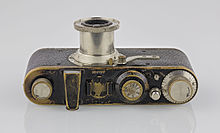
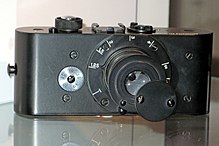
The first 35 mm film Leica prototypes were built by Oskar Barnack at Ernst Leitz Optische Werke, Wetzlar, in 1913. Some say the original Leica was intended as a compact camera for landscape photography, particularly during mountain hikes, but other sources indicate the camera was intended for test exposures with 35mm motion picture film. The Leica was the first practical 35 mm camera that used standard cinema 35 mm film. The Leica transports the film horizontally, extending the frame size to 24×36mm with a 2:3 aspect ratio, instead of the 18×24 mm of cinema cameras, which transport the film vertically.
The Leica had several model iterations, and in 1923, Barnack convinced his boss, Ernst Leitz II, to make a preproduction series of 31 cameras for the factory and outside photographers to test. Though the prototypes received mixed reception, Ernst Leitz decided in 1924 to produce the camera. It was an immediate success when introduced at the 1925 Leipzig Spring Fair as the Leica I (for Leitz camera). The focal plane shutter has a range from 1/20 to 1/500 second, in addition to a Z for Zeit (time) position.
Barnack conceived the Leica as a small camera that produced a small negative. To make large photos by enlargement, (the "small negative, large picture" concept) requires that the camera have high quality lenses that could create well-defined negatives. Barnack tried a Zeiss Tessar on his early prototype camera, but because the Tessar was designed for the 18×24 mm cine format, it inadequately covered the Leica's 24×36mm negative. Barnack resorted to a Leitz Mikro-Summar 1:4.5/42 mm lens for the prototype, but to achieve resolution necessary for satisfactory enlargement, the 24x36 mm format needed a lens designed specially for it. The first Leica lens was a 50 mm f/3.5 design based on the Cooke triplet of 1893, adapted by Max Berek at Leitz. The lens has five elements in three groups—the third group being three cemented elements—and was initially named the Leitz Anastigmat. Unlike other triplets, the Leitz Anastigmat has the diaphragm between the first and second elements. When the Leica was first vended, this lens was renamed the ELMAX, for E Leitz and Max Berek. By 1925, the Leitz laboratories had produced glasses with improved optical properties, and Professor Berek designed an improved version of the ELMAX named the ELMAR that had four elements in three groups. The third group was simplified to two cemented elements, which was easier and cheaper to make. Professor Berek had two dogs, Hektor and Rex. The first of these, Hektor, gave his name to a series of Leica lenses, and the name of the second appeared in the SummaREX.
In 1930, the Leica I Schraubgewinde was first produced. It had an exchangeable lens system based on a 39mm diameter screw thread, often referred to as the Leica Thread Mount or LTM. In addition to the 50 mm normal lens, a 35 mm wide angle and a 135 mm telephoto lens were initially available. During the mid-1930s, a legendary soft-focus lens, the Thambar 90 mm f/2.2 was designed, and made in small numbers between 1935 and 1949, no more than 3000 units. It is now a rare collector's item. In 2017, a new version was produced, costing $6,495. A lens from the original series can fetch between $3,000 and $8,000, depending on condition.
The Leica II was first produced in 1932, with a built in rangefinder coupled to the lens focusing mechanism. This model has a separate viewfinder (showing a reduced image) and rangefinder. In 1932, the flange to filmplane was standardised to 28.8mm, first implemented on Leica model C, and the Leica Standard the next year.
The Leica III added slow shutter speeds down to 1 second, and the model IIIa added the 1/1000 second shutter speed. The IIIa is the last model made before Barnack's death, and therefore the last model for which he was wholly responsible. Leitz continued to refine the original design through to 1957. The final version, the IIIg, includes a large viewfinder with several framelines. These models all have a functional combination of circular dials and square windows.
Early Leica cameras bear the initials D.R.P., which stands for Deutsches Reichspatent, the name for German patents before May 1945. This is probably a reference to German patent No. 384071 "Rollfilmkamera" granted to Ernst Leitz, Optische Werke in Wetzlar, on November 3, 1923.
The company had always had progressive labor policies which encouraged the retention of skilled workers, many of whom were Jewish. Ernst Leitz II, who began managing the company in 1920, responded to the election of Hitler in 1933 by helping Jews to leave Germany, by "assigning" hundreds (even if they were not actually employees) to overseas sales offices where they were helped to find jobs. The effort intensified after Kristallnacht in 1938, until the borders were closed in September 1939. The extent of what came to be known as the "Leica Freedom Train" only became public after his death, well after the war.
After WWII
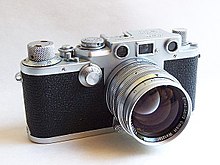
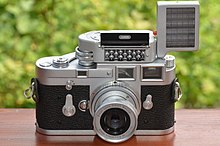
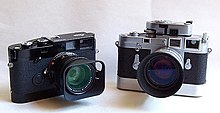

After the war, Leitz continued to produce the late versions of the Leica II and the Leica III through the 1950s. However, in 1954, Leitz introduced the Leica M3, with the new Leica M mount, a bayonet-like lens mount. The new camera also combined the rangefinder and viewfinder into one large, bright viewfinder with a brighter double image in the center. This system also introduced a system of parallax compensation and a new rubberized, reliable, focal-plane shutter. Leica continues to refine this model (the latest versions being the MP and MA, both of which have framelines for 28, 35, 50, 75, 90, and 135 mm lenses, which show automatically upon mounting).
In 1952, Günther Leitz decided to establish Ernst Leitz Canada at Midland, Ontario.
Post-war models bear the initials DBP, standing for Deutsches Bundespatent (Federal German Patent), instead of the DRP (Deutsches Reich patent) found on pre-war models. A number of camera companies have built models based on the Leica rangefinder design. These include the Leotax, Nicca and early Canon models in Japan, the Kardon in USA, the Reid in England and the FED and Zorki in the USSR.
In the 1970s, Walter Mandler introduced computer aided design in optical engineering.
Until at least the mid-1950s, Leitz offered factory upgrades of earlier Leica cameras to the current model's specifications. The upgraded cameras retained their original serial number.
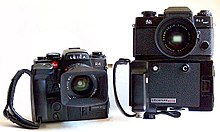

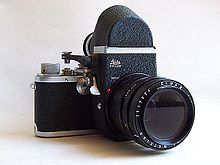
From 1964, Leica produced a series of single-lens reflex cameras, beginning with the Leicaflex, followed by the Leicaflex SL, the Leicaflex SL2, and then the R series from R3 to R7, made in collaboration with the Minolta Corporation. The Leica R8 was entirely designed and manufactured by Leica. The final model was the Leica R9, which could be fitted with the Digital Module back. Leica was slow to produce an auto-exposure model, and never made a Leica R model that included auto-focusing. In 2009 the R-series was discontinued, citing new camera developments that had caused a massive loss of Leica sales.
Conceptually intermediate between the Rangefinder Leicas and the SLR Leicas was the Leica Visoflex System, a mirror reflex box that attached to the lens mount of Leica rangefinders (separate versions were made for the screwmount and M series bodies) and accepted lenses made especially for the Visoflex System. Rather than using the camera's rangefinder, focusing was via a groundglass screen. A coupling released both mirror and shutter to make the exposure. Camera rangefinders are inherently limited in their ability to accurately focus long focal-length lenses; the mirror reflex box permitted much longer length lenses. Throughout its history, Leitz has been responsible for numerous optical innovations, such as aspherical production lenses, multicoated lenses, and rare earth lenses.
The earliest Leica reflex housing was the PLOOT (Leitz's five letter code for its products), announced in 1935, along with the 200 mm f/4.5 Telyt Lens. This date is significant because it places Leica among the 35 mm SLR pioneers. Until the 1964 introduction of the Leicaflex, the PLOOT and Visoflex were Leica's only SLR offerings. A redesigned PLOOT was introduced by Leica in 1951 as the Visoflex I. This was followed by a much more compact Visoflex II in 1960 (which was the only Visoflex version available in both LTM screwmount and M-bayonet), and the Visoflex III with instant-return mirror in 1964. Leica lenses for the Visoflex system included focal lengths of 65, 180 (rare), 200, 280, 400, 560, and 800mm. In addition, the optical groups of many rangefinder lenses could be removed and attached to the Visoflex via a system of adapters. The Visoflex system was discontinued in 1984. The leica M6, the top model in the company's M 35mm rangefinder camera line at the time, served as the model for this one.
Leica offered a wide range of accessories. For instance, LTM (screwmount) lenses could be used on M cameras via an adapter. Similarly, Visoflex lenses could be used on the Leicaflex and R cameras with an adapter. Furthermore, certain LTM and M rangefinder lenses featured removable optical groups that could mount via adapters on the Visoflex system, thus making them usable as rangefinder or SLR lenses for Visoflex-equipped Screwmount and M rangefinder cameras, as well as being usable on Leicaflex and R cameras. Leica also offered focusing systems, such as the Focorapid and Televit, that could replace certain lenses' helicoid mounts for sports and natural-life telephotography.
'Leitz' to 'Leica'

In 1986, the Leitz company changed its name to Leica (LEItz CAmera), due to the fame of the Leica tradename. At this time, Leica relocated its factory from Wetzlar (Germany) to the nearby town of Solms (Germany). In 1996, Leica Camera separated from the Leica Group and became a publicly owned company. In 1998, the Leica group was divided into two independent units: Leica Microsystems and Leica Geosystems.
On 1 October 2012, Leica Camera AG was delisted from the Frankfurt Stock Exchange after Lisa Germany Holding GmbH acquired the remaining minority shares stock resulting in the company being owned privately.
On 26 November 2013, Leica Camera AG announced the purchase of Sinar Photography AG, Zurich, the Swiss manufacturer of view cameras.
In May 2014, Leica Camera AG finished building a new factory at Leitz Park 1 in the new industrial part of Wetzlar and relocated back to the city where it started.
In April 2019, a television commercial for Leica titled "The Hunt" was released online. The commercial depicts photojournalists in war-torn and politically unstable environments; one of whom takes a photograph of the Tank Man during the 1989 Tiananmen Square protests. Following censorship of the Leica brand on Sina Weibo, Leica revoked the commercial and sought to distance themselves from it, claiming the company did not sanction its production.
In September 2022, Leica announced Cine 1, a laser projector, for release in 2023. The model is Leica's return to digital projectors, which the company produced under the Pradovit brand.
Notable adherents and photographers
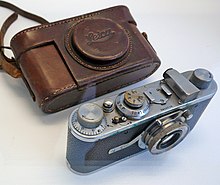
Leica cameras are particularly associated with street photography, especially in the latter twentieth century; they were used by photographers such as Henri Cartier-Bresson and Sebastião Salgado.
Antique trade and collecting
Leica cameras, lenses, accessories and sales literature are collectible. There are dozens of Leica books and collector's guides, notably the three-volume Leica, an Illustrated History by James L. Lager. Early or rare cameras and accessories can sell for very high prices. For instance, an anonymous buyer bought a rare 1923 Leica camera for 2.6 million euros ($2.8 million) at an auction in Vienna. Notably, Leica cameras with military markings are highly valued; this started a market for refurbished Soviet copies with fake markings.
Cameras
Main article: List of Leica Camera modelsThe earliest Leica prototypes were developed by the company Ernst Leitz GmbH during the first years of the 20th century, but marketing did not commence until the mid-1920s. The Leicas were innovative, by orienting the image frame sideways for the 35 mm film as opposed to the cine-camera tradition of across the film strip. The cameras were compact with collapsible lenses, for hiking and biking. The rangefinder feature was added to the Leica II in 1932, and that year both rangefinder and viewfinder cameras became available with interchangeable lenses. In 1933 the Leica III offered slow-speed shutter controls and a fast 1/1000 s shutter speed, and various iterations of the III (a,b,c,d,f,&g) series became the flagship models and best sellers into the late 1950s. Further iterations of models I and II were offered but did not sell well.
Prior to WWII, Leica and competing Contax cameras from Zeiss Ikon were considered to be the finest 35 mm cameras, but post-WWII the companies had competition from Soviet and Japanese copies. During the 1950s Japanese quality and innovation, along with low pricing, devastated the European camera industry. Leica became an expensive type of camera bought largely by professional or serious photographers. However, the advent of reflex camera technology made rangefinders somewhat obsolete, leaving Leica the main product of a diminishing market segment. Leica has remained a notable tradename into the 21st Century.
The original producer of the cameras, Ernst Leitz GmbH, is now three independent companies: Leica Camera AG, Leica Geosystems AG, and Leica Microsystems GmbH, which manufacture cameras, geo survey equipment, and microscopes, respectively. Leica Microsystems GmbH owns the Leica brand and licenses its use to the other two companies.
Cooperation
Main articles: L-Mount Alliance and Lumix § Leica model crossover

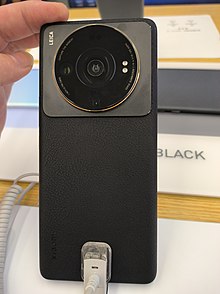

During the 2018 Photokina in Cologne, Leica announced that Sigma and Panasonic had become licensed for the L-mount platform. The three companies would form a strategic and technical alliance, yet remain independent.
Leica-branded lenses, such as some Nocticron, Elmarit and Summilux lenses, have been used on many Panasonic (Matsushita) digital cameras (Lumix) and video recorders since 1995. Panasonic/Leica models were the first to incorporate optical image stabilization in their digital cameras. Several Panasonic/Leica lenses have been produced for the Micro Four Thirds mount, including the 12 mm f/1.4 Summilux, 15 mm f/1.7 Summilux and 25 mm f/1.4 Summilux prime lenses, and zooms including a 12–60 mm f/2.8–4 and 100–400 mm f/4–6.3.
Leica and Minolta signed a technical cooperation agreement in June 1972.
- Minolta XE chassis became the basis for the Leica R3 SLR – cooperative development with Copal on the 'Copal-Leitz Square' electronic shutter module, with advanced gear train and self-timer.
- Minolta XD chassis and microelectronics became the basis for the Leica R4 SLR.
- Several lenses for the above cameras including the MC/MD 24mm F2.8 (Leica Elmarit-R, glass by Minolta but case Made In Germany); the (1983) MD Zoom 35–70 F3.5 (Vario-Elmar-R); (1978) Minolta MD 75–200 F4.5.
- Leica 'Leitz-Minolta' CL and CLE (Compact Leica Electronic)
- Minolta co-designed and produced the following lenses for the above cameras:
- M-Rokkor 40mm F2 (Summicron-C – Made in Germany);
- M-Rokkor 90mm F4 'Made by Leitz in Germany' (Elmar-C – Made in Germany and later in Japan by Minolta). This lens was solely designed by Minolta, being remarkable for one of a few Japanese lenses to be made in Germany. The lens elements were produced by Minolta in Japan.
- M-Rokkor 28mm F2.8. This lens is not the same as any of the Leica M 28mm F2.8's, being a 7 element, 5 group design while contemporary Leicas were 8e/6g (Elmarit II '72–'79 and Elmarit-M III '79–'93). The M-Rokkor was sold for about less than half the price – however Modern Photography tests indicated that performance was as good as the Leica equivalent. This is supported by user experiences and modern tests.
- Minolta co-designed and produced the following lenses for the above cameras:
In 2020, Leica entered a strategic partnership with Insta360 to help produce the ONE R 1-Inch Edition. Since then, ONE R has been recognised as one of TIME magazine's best inventions of 2020.
Since 2016, Leica has established partnership with the Chinese telecommunications company Huawei, and Leica cameras will be co-engineered into Huawei smartphones, including the P series and Mate series. The first smartphone to be co-engineered with a Leica camera was the Huawei P9. The partnership ended with the Huawei P50 series in 2021.
In 2021, Leica has established technology partnership with Sharp Corporation, and Leica cameras will be co-engineered into Sharp smartphones for the Japanese market only. The first smartphone to be co-engineered with a Leica camera was the AQUOS R6 with 1-inch-sensor camera. Then Leica with the SoftBank introduced the smartphone Leitz Phone 1 which have same specifications as AQUOS R6 but different design.
In 2022, Leica entered a strategic partnership with Xiaomi to jointly develop Leica cameras to be used in Xiaomi flagship smartphones, succeeding the partnership between Huawei and Leica. The first flagship smartphones under this new partnership were the Xiaomi 12S Ultra and Xiaomi MIX Fold 2, launched in July and August 2022, respectively.
In 2014, to commemorate Leica camera's 100th anniversary, they partnered with Swiss watch manufacture Valbray to develop a limited edition chronograph wristwatch with Valbray's signature Leica aperture inspired dial.
Leica lenses
| This section needs expansion with: Summary of the lens types. You can help by adding to it. (June 2023) |
Financials
Leica was traded as LCA1 on the Frankfurt stock exchange until October 2012.
See also
References
- ^ "Umbrüche in Fortoindustrie: Kamerahersteller Leica streicht 80 Stellen" (in German). 13 September 2019. Retrieved 28 October 2019.
- Schuetze, Arno. "Exclusive: Blackstone in talks to sell stake in camera maker Leica..." U.S. Retrieved May 15, 2018.
- "Wetzlar, Optische Werke Ernst Leitz (Leica)". Route der Industriekultur Mittelhessen (in German). Archived from the original on September 27, 2020. Retrieved December 7, 2017.
- "DenkXweb – Detailansicht". denkxweb.denkmalpflege-hessen.de. Retrieved December 7, 2017.
- Wade, John. The Leica I: The Camera that Changed Photography. Shutterbug, Jul 13, 2015.
- Die Leica. 1933 No. 6. "Was ist eigentlich "Elmar"?
- Leica: The First Sixty Years. Gianni Rogliatti. Hove Collectors Books, 1985. ISBN 1-874707-02-2
- The Leitz Thambar 90 mm f/2.2 Why Is It Considered A Legendary Portrait Lens? By Roger W. Hicks, Shutterbug Posted: April 1, 2005
- "Technical data on the Leitz Thambar f/2.2", Thorsten Overgaard.
- Leica Collectors Guide, Dennis Delaney, Hove Collectors Books, Hove 1992, ISBN 1-874707-00-6
- Gandy, Stephen (October 18, 2008). "Leica Screw Mount Serial #'s Sorted by Number". Stephen Gandy's CameraQuest.
- "Upgrading your Leica", Thorsten Overgaard.
- Leica cease production of R9 and R lenses March 25, 2009
- "Hauptaktionär übernimmt alle Anteile der Leica Camera AG". Das Evertiq News Network. October 3, 2012. Retrieved December 5, 2016.
- "Leica Camera AG takes over Sinar Photography AG, the Swiss manufacturer of view cameras". Leica Camera AG. November 26, 2013. Archived from the original on October 1, 2020. Retrieved December 5, 2016.
- "Visiting The New Leica Campus in Wetzlar", Thorsten Overgaard.
- Graham-Harrison, Emma (19 April 2019). "Camera firm distances itself from Tiananmen Square advert". The Guardian. Retrieved 27 April 2019.
- Ricker, Thomas; Porter, Jon (1 September 2022). "Leica is now making a Cine 1 laser projector that sits just inches from the wall". The Verge. Retrieved 1 September 2022.
- Bunyan, Dr Marcus (6 January 2015). "Leica street photography". Art Blart. Retrieved 2022-11-07.
- "Leica: the camera that freed the world – in pictures". The Guardian. 13 July 2017. ISSN 0261-3077. Retrieved 2018-09-25 – via www.theguardian.com.
- Thompson, Robyn (May 13, 2012). "Leica camera auctioned in Austria for record $2.8 mLn". Reuters. REUTERS. Archived from the original on January 4, 2016. Retrieved February 16, 2015.
- Auction results for Luftwaffe Leica cameras
- "Home". l-mount.com.
- "1995: Matsushita (Panasonic) started making all their cameras with Leica lenses", Thorsten Overgaard.
- Year and month: Francesch, p. 49.
- Waloszek, Gerd. "Leica M (Typ 240): Minolta Rokkor 28mm f/2.8". waloszek.de. Retrieved 6 November 2018.
- al_kaplan (October 15, 2004). "Question about an M-Rokkor 28mm f2.8 (Minolta)". photo.net. Retrieved 6 November 2018.
- Jesse. "Minolta M Rokkkor 28mm f2.8". jumboprawn.net. Archived from the original on March 5, 2019. Retrieved 6 November 2018.
- "Leica Camera AG and Insta360 Announce Strategic Partnership to Reinvent the Action Cam // 2020 // Press Releases // Press Centre // Company - Leica Camera AG". us.leica-camera.com. Retrieved 2020-12-31.
- "Insta360 One R: The 100 Best Inventions of 2020". Time. Retrieved 2021-01-04.
- "Huawei and Leica Camera announce long-term technology partnership for the reinvention of smartphone photography". Leica Camera (Press release).
- "After Xiaomi/Leica deal, Huawei confirms end of Leica partnership". Android Authority. 2022-05-23. Retrieved 2022-06-30.
- "Leica Camera AG and Sharp Corporation announce technology partnership in the smartphone photography segment for the Japanese market // 2021 // Press Releases // Press Centre // Company - Leica Camera AG". us.leica-camera.com. Retrieved 2021-06-28.
- "Leitz Phone 1 is a Leica-branded phone exclusive to Japan". GSMArena.com. Retrieved 2021-06-28.
- "Mi Global Home". Mi Global Home. Retrieved 2022-05-23.
- Doerr, Elizabeth (27 May 2014). "Leica's Very Special Limited Edition EL 1 Chrono With Valbray". Quill & Pad.
External links
- Official website
- Leica Cameras collection at the Smithsonian National Museum of American History
- Leica History and Heritage
| Leica Camera | ||||||||||
|---|---|---|---|---|---|---|---|---|---|---|
| Rangefinder |
|  | ||||||||
| Single-lens reflex |
| |||||||||
| Mirrorless |
| |||||||||
| Digital compact | ||||||||||
| Camera lens | ||||||||||
| People | ||||||||||
| Other | ||||||||||
| Leica M mount digital cameras | |||||||||||||||||||||||||||||||||||||||||||||||||||||||||||||||||||||||||||||||||||||||||||||||||||||||||||||||||||||||||||||||||||||||||||||||||||||||||||||||||||||||||||||||||||||||||||||||||||||||||||||||||||||||||||||||||||||||||||||||||||||||||||||||||||||||||||||||||||||||||||||||||||||||||||||||||||||||||||||||||||||||||||||||||||||||||||||||||||||||||||||||||||||||||||||||||||||||||||||||||||||||||||||||||||||||||||||||||||||||||||||||||||||||||||||||||||||||||||||||||||||||||||||||||||||||||||||||||||||||||||||||||||||||||||||||||||||||||||
|---|---|---|---|---|---|---|---|---|---|---|---|---|---|---|---|---|---|---|---|---|---|---|---|---|---|---|---|---|---|---|---|---|---|---|---|---|---|---|---|---|---|---|---|---|---|---|---|---|---|---|---|---|---|---|---|---|---|---|---|---|---|---|---|---|---|---|---|---|---|---|---|---|---|---|---|---|---|---|---|---|---|---|---|---|---|---|---|---|---|---|---|---|---|---|---|---|---|---|---|---|---|---|---|---|---|---|---|---|---|---|---|---|---|---|---|---|---|---|---|---|---|---|---|---|---|---|---|---|---|---|---|---|---|---|---|---|---|---|---|---|---|---|---|---|---|---|---|---|---|---|---|---|---|---|---|---|---|---|---|---|---|---|---|---|---|---|---|---|---|---|---|---|---|---|---|---|---|---|---|---|---|---|---|---|---|---|---|---|---|---|---|---|---|---|---|---|---|---|---|---|---|---|---|---|---|---|---|---|---|---|---|---|---|---|---|---|---|---|---|---|---|---|---|---|---|---|---|---|---|---|---|---|---|---|---|---|---|---|---|---|---|---|---|---|---|---|---|---|---|---|---|---|---|---|---|---|---|---|---|---|---|---|---|---|---|---|---|---|---|---|---|---|---|---|---|---|---|---|---|---|---|---|---|---|---|---|---|---|---|---|---|---|---|---|---|---|---|---|---|---|---|---|---|---|---|---|---|---|---|---|---|---|---|---|---|---|---|---|---|---|---|---|---|---|---|---|---|---|---|---|---|---|---|---|---|---|---|---|---|---|---|---|---|---|---|---|---|---|---|---|---|---|---|---|---|---|---|---|---|---|---|---|---|---|---|---|---|---|---|---|---|---|---|---|---|---|---|---|---|---|---|---|---|---|---|---|---|---|---|---|---|---|---|---|---|---|---|---|---|---|---|---|---|---|---|---|---|---|---|---|---|---|---|---|---|---|---|---|---|---|---|---|---|---|---|---|---|---|---|---|---|---|---|---|---|---|---|---|---|---|---|---|---|---|---|---|---|---|---|---|---|---|---|---|---|---|---|---|---|---|---|---|---|---|---|---|---|---|---|---|---|---|---|---|---|---|---|---|---|---|---|---|---|---|---|---|---|---|---|---|---|---|---|---|---|---|---|---|---|---|---|---|---|---|---|---|---|---|---|---|---|---|---|---|---|---|---|---|---|---|---|---|---|---|---|---|---|---|---|---|---|---|---|---|---|---|---|---|---|---|---|---|---|---|---|---|---|---|---|---|---|---|---|---|---|
Digital types: M = Professional |
ME = Entry level |
MM = Monochrom |
MD = No display
MR = Increased resolution | |||||||||||||||||||||||||||||||||||||||||||||||||||||||||||||||||||||||||||||||||||||||||||||||||||||||||||||||||||||||||||||||||||||||||||||||||||||||||||||||||||||||||||||||||||||||||||||||||||||||||||||||||||||||||||||||||||||||||||||||||||||||||||||||||||||||||||||||||||||||||||||||||||||||||||||||||||||||||||||||||||||||||||||||||||||||||||||||||||||||||||||||||||||||||||||||||||||||||||||||||||||||||||||||||||||||||||||||||||||||||||||||||||||||||||||||||||||||||||||||||||||||||||||||||||||||||||||||||||||||||||||||||||||||||||||||||||||||||||
| Leica M mount film cameras | ||||||||||||||||||||||||||||||||||||||||||||||||||||||||||||||||||||||||||||||||||||||||||||||||||||||||||||||||||||||||||||||||||||||||||||||||||||||||||||||||||||||||||||||||||||||||||||||||||||||||||||||||||||||||||||||||||||||||||||||||||||||||||||||||||||||||||||||||||||||||||||||||||||||||||||||||||||||||||||||||||||||||||||||||||||||||||||||||||||||||||||||||||||||||||||||||||||||||||||||||||||||||||||||||||||||||||||||||||||||||||||||||||||||||||||||||||||||||||||||||||||||||||||||||||||||||||||||||||||||||||||||||||||||||||||||||||||||||||||||||||||||||||||||||||||||||||||||||||||||||||||||||||||||||||||||||||||||
|---|---|---|---|---|---|---|---|---|---|---|---|---|---|---|---|---|---|---|---|---|---|---|---|---|---|---|---|---|---|---|---|---|---|---|---|---|---|---|---|---|---|---|---|---|---|---|---|---|---|---|---|---|---|---|---|---|---|---|---|---|---|---|---|---|---|---|---|---|---|---|---|---|---|---|---|---|---|---|---|---|---|---|---|---|---|---|---|---|---|---|---|---|---|---|---|---|---|---|---|---|---|---|---|---|---|---|---|---|---|---|---|---|---|---|---|---|---|---|---|---|---|---|---|---|---|---|---|---|---|---|---|---|---|---|---|---|---|---|---|---|---|---|---|---|---|---|---|---|---|---|---|---|---|---|---|---|---|---|---|---|---|---|---|---|---|---|---|---|---|---|---|---|---|---|---|---|---|---|---|---|---|---|---|---|---|---|---|---|---|---|---|---|---|---|---|---|---|---|---|---|---|---|---|---|---|---|---|---|---|---|---|---|---|---|---|---|---|---|---|---|---|---|---|---|---|---|---|---|---|---|---|---|---|---|---|---|---|---|---|---|---|---|---|---|---|---|---|---|---|---|---|---|---|---|---|---|---|---|---|---|---|---|---|---|---|---|---|---|---|---|---|---|---|---|---|---|---|---|---|---|---|---|---|---|---|---|---|---|---|---|---|---|---|---|---|---|---|---|---|---|---|---|---|---|---|---|---|---|---|---|---|---|---|---|---|---|---|---|---|---|---|---|---|---|---|---|---|---|---|---|---|---|---|---|---|---|---|---|---|---|---|---|---|---|---|---|---|---|---|---|---|---|---|---|---|---|---|---|---|---|---|---|---|---|---|---|---|---|---|---|---|---|---|---|---|---|---|---|---|---|---|---|---|---|---|---|---|---|---|---|---|---|---|---|---|---|---|---|---|---|---|---|---|---|---|---|---|---|---|---|---|---|---|---|---|---|---|---|---|---|---|---|---|---|---|---|---|---|---|---|---|---|---|---|---|---|---|---|---|---|---|---|---|---|---|---|---|---|---|---|---|---|---|---|---|---|---|---|---|---|---|---|---|---|---|---|---|---|---|---|---|---|---|---|---|---|---|---|---|---|---|---|---|---|---|---|---|---|---|---|---|---|---|---|---|---|---|---|---|---|---|---|---|---|---|---|---|---|---|---|---|---|---|---|---|---|---|---|---|---|---|---|---|---|---|---|---|---|---|---|---|---|---|---|---|---|---|---|---|---|---|---|---|---|---|---|---|---|---|---|---|---|---|---|---|---|---|---|---|---|---|---|---|---|---|---|---|---|---|---|---|---|---|---|---|---|---|---|---|---|---|---|---|---|---|---|---|---|---|---|---|---|---|---|---|---|---|---|---|---|---|---|---|---|---|---|---|---|---|---|---|---|---|---|---|---|---|---|---|---|---|---|---|---|---|---|---|---|---|---|
Mechanical | Mechanical TTL | Electronic Controlled Shutter TTL | ||||||||||||||||||||||||||||||||||||||||||||||||||||||||||||||||||||||||||||||||||||||||||||||||||||||||||||||||||||||||||||||||||||||||||||||||||||||||||||||||||||||||||||||||||||||||||||||||||||||||||||||||||||||||||||||||||||||||||||||||||||||||||||||||||||||||||||||||||||||||||||||||||||||||||||||||||||||||||||||||||||||||||||||||||||||||||||||||||||||||||||||||||||||||||||||||||||||||||||||||||||||||||||||||||||||||||||||||||||||||||||||||||||||||||||||||||||||||||||||||||||||||||||||||||||||||||||||||||||||||||||||||||||||||||||||||||||||||||||||||||||||||||||||||||||||||||||||||||||||||||||||||||||||||||||||||||||||
| Leica R mount bodies | |||||||||||||||||||||||||||||||||||||||||||||||||||||||||||||||||||||||||||||||||||||||||||||||||||||||||||||||||||||||||||||||||||||||||||||||||||||||||||||||||||||||||||||||||||||||||||||||||||||||||||||||
|---|---|---|---|---|---|---|---|---|---|---|---|---|---|---|---|---|---|---|---|---|---|---|---|---|---|---|---|---|---|---|---|---|---|---|---|---|---|---|---|---|---|---|---|---|---|---|---|---|---|---|---|---|---|---|---|---|---|---|---|---|---|---|---|---|---|---|---|---|---|---|---|---|---|---|---|---|---|---|---|---|---|---|---|---|---|---|---|---|---|---|---|---|---|---|---|---|---|---|---|---|---|---|---|---|---|---|---|---|---|---|---|---|---|---|---|---|---|---|---|---|---|---|---|---|---|---|---|---|---|---|---|---|---|---|---|---|---|---|---|---|---|---|---|---|---|---|---|---|---|---|---|---|---|---|---|---|---|---|---|---|---|---|---|---|---|---|---|---|---|---|---|---|---|---|---|---|---|---|---|---|---|---|---|---|---|---|---|---|---|---|---|---|---|---|---|---|---|---|---|---|---|---|---|---|---|---|---|
Collaboration with Minolta | |||||||||||||||||||||||||||||||||||||||||||||||||||||||||||||||||||||||||||||||||||||||||||||||||||||||||||||||||||||||||||||||||||||||||||||||||||||||||||||||||||||||||||||||||||||||||||||||||||||||||||||||